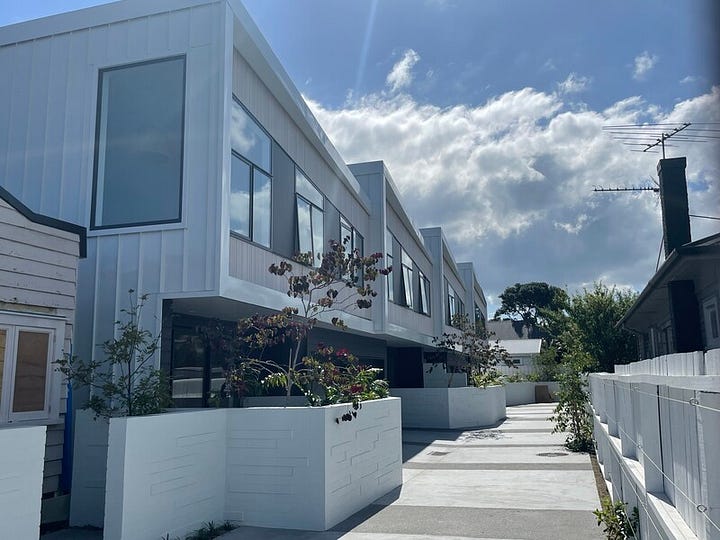Defining urban intensification in Aotearoa
Intensification and housing more broadly is a hot topic across the country, particularly in the media. One recent article described Hamilton City Councillors are “uneasy” about the idea of 70% of Hamilton’s new housing being infill. This raises a question of what is meant by infill? I believe urban intensification in Aotearoa can be split into three broad categories. ‘Infill’ only describes one these categories. The proposed goal in the Hamilton Urban Growth Strategy (HUGS), is for 70% of new homes to be located within the existing urban area. How this will split into the following three categories is less certain and depends on a variety of political decisions.
Urban infill
Urban infill, or simply infill development, is building on unused or underutilised space within existing urban fabric. Leaving existing houses in place and developing the remaining land. This has been quite common in recent decades, especially with large ¼ acre sections being split into two or three smaller sections, each with a large house.
Occasionally, infill development can include duplexes or terraced housing, like the development in Point Chevalier shown below.




Urban redevelopment
Urban redevelopment is where the existing buildings are removed and replaced with multiple new homes. This can allow a complete rethink of how the space is used. Often, giving better consideration of the orientation of the buildings, location of driveways, open space, outlooks from living rooms etc.
Urban redevelopment can include developments where the developer acquires multiple neighbouring sites and amalgamates these. This typically delivers better connectivity, better outlook spaces and higher yield. However, it is still a step down in the scale, master planning and outcomes that occurs in Urban Regeneration areas.
Urban regeneration
Urban regeneration is where coordinated redevelopment is undertaken on a neighbourhood or suburb scale. Typically in New Zealand, it is in sites where local or central government has a significant land holding, which they can leverage to fund the urban regeneration and reshape the streets and other infrastructure to support the increased population. It typically involves greater masterplanning with a focus on delivering better street grid for walkability, placement of higher density development, inclusion of public space and stormwater management. This can deliver significant improvements to an area but does create disruption for the existing community.

A great example of urban regeneration that is nearly completed, is Roskill South. It is one neighbourhood in the Kāinga Ora Roskill large-scale development area in Tāmaki Makaurau. The area was developed in the 1950’s as a low density suburb. The project is replacing around 260 older state houses with over 900 new homes, 310 of which will be new state housing and the rest being affordable and market housing. It also delivering significant infrastructure upgrades and renewals, including new street connections and public green spaces.
Why does this matter?
There will be some development which sit somewhere between these categorisations. However, most development will clearly be one of those three. Having these definitions are important for setting expectations with the public and improving accessibility to public conversation on these matters.
Linking back to the original article about Hamilton. The development will mostly be a mix of infill and urban redevelopment. Understanding what this could look like will enable Hamilton residents to discuss what is needed to support the increased population. Areas where a lot of urban redevelopment occurs will require greater resources. How on street parking is managed will likely be a key point discussion, as will access to public open space, good transport options and local shops and amenities. Urban regeneration projects are also possible and could deliver significant benefits but none have been signaled yet.
Increasing density is critical for our future, to address climate change, housing affordability and creating vibrant, liveable urban areas. Therefore, it is important that we improve the dialogue in our media, within the industry and with communities, if we are to have the conversations required to generate better outcomes.




